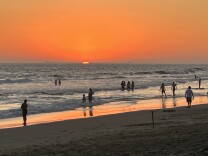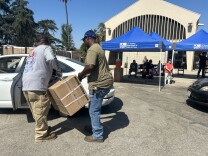
Next Up:
0:00
0:00
-
Listen Listen
Climate & Environment
The report concludes that the water supply was too slow, not too low, and even a functioning reservoir likely wouldn’t have stopped the Palisades Fire.
Listen
0:42
Sponsored message
More Stories
-
If you were affected by the January wildfires and haven't put in for federal assistance yet, the clock is ticking.
-
The governor has proposed spending climate bond money dedicated to wildfire mitigation in various ways.
-
The National Oceanic and Atmospheric Administration houses key groups like the National Weather Service. Experts warn the consequences of employee cuts could be drastic.
-
The hottest days of the week are on their way out.
-
Officials say the report, released Thursday, is the first comprehensive analysis of the true cost of the wildfires.
-
The hottest days of the week are on their way out.
-
More than 40 sea lions have shown up on the beach with signs of neurotoxin sickness.
-
Some 1,000 NPS employees were fired, and hiring for seasonal positions was delayed. Here's what to know about the impacts already being felt at parks, and what it could mean for the busy season.
-
Officials say our dry winter is partly to blame for the smaller blooms.
-
For years, experts warned against developing the unstable cliff top, but property owners prevailed. Now they’re paying the price.
-
The hottest days of the week are here.
-
The L.A. County Board of Supervisors approves changes to some landfill rules to allow wildfire debris to be sent to sites in Calabasas, Sylmar and Lancaster.
Philanthropic funds helped purchase a burned lot that used to have 14 rental units. Supporters hope the project can be a model for rebuilding equitably for renters.
Listen
0:42
Support your source for local news!
In case you missed it
-
911 recordings obtained by LAist shed light on why and how emergency planning continues to leave people with disabilities behind.
-
LAist investigates illicit dumping at three Antelope Valley sites.
-
An LAist investigation found toxic heavy metals in samples of fire retardant collected from the Palisades, Eaton and Franklin fires. Here's what that means.
More Stories
-
Farmers in California are trying to plant crops that don't require a lot of water. Some are turning to growing agave as a response to a warming state.Listen 4:19
-
We're looking at 10 degrees cooler across the Southland.
-
Some 65,600 structures, 13,000 under evacuation orders, remain threatened as the fire burns in steep terrain.
-
Nearly half the water drawn from the Colorado River goes to grow feed for beef and dairy cows. Researchers say modest changes in American diets could help the river — and the climate.Listen 46:06
-
Bold cabernet sauvignon wines made Napa Valley famous. Now, hotter temperatures are starting to damage the grapes, so some wineries are starting to experiment.Listen 4:31
-
Hundreds of people age 60 and above waited in line to get portable AC units in Lincoln Heights.
-
Fire officials said OC Public Works was moving boulders when the fire ignited in Trabuco Canyon.
-
The sunlight sparks reactions in the air that are harmful to our heart and respiratory systems, but extreme heat accelerates it.
-
Each county in Southern California has its own way of doing things. Here’s a list of emergency alert systems to sign up for so you’ll always be in the know.
-
It's going to be another warm one before cool down kicks in.




































